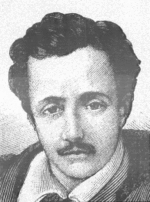Antoine Thomson d'Abbadie
| Antoine Thomson d'Abbadie | |
|---|---|

Antoine Thomson d'Abbadie
|
|
| Born |
3 January 1810 Dublin, Ireland |
| Died |
19 March 1897 (aged 87) Paris, France |
| Citizenship | France |
| Nationality | Irish, French, Basque |
| Fields | Geographer |
Antoine Thomson d'Abbadie d'Arrast (3 January 1810 – 19 March 1897) was a French explorer, geographer, ethnologist, linguist and astronomer notable for his travels in Ethiopia during the first half of the 19th century. He was the older brother of Arnaud Michel d'Abbadie, with whom he traveled.
He was born in the (then) British city of Dublin, Ireland, from a partially Basque noble family of the French province of Soule. His father, Michel Abbadie, was born in Arrast-Larrebieu and his mother was Irish. His grandfather Jean-Pierre was an abbot and a notary in Soule. The family moved to France in 1818 where the brothers received a careful scientific education. In 1827, Antoine received a bachelier (bachelor) degree in Toulouse. Starting in 1829, he began his education in Paris, where he studied law.
He married Virginie Vincent de Saint-Bonnet on 21 February 1859, and settled in Hendaye where he purchased 250ha to build a castle, and became the mayor of the city from 1871 to 1875.
Abbadie was a knight of the Legion of Honour, which he received on 27 September 1850, and a member of the French Academy of Sciences. He died in 1897, and bequeathed the Abbadi domain and castle in Hendaye, yielding 40,000 francs a year, to the Academy of Sciences.
In 1835 the French Academy sent Antoine on a scientific mission to Brazil, the results being published at a later date (1873) under the title of Observations relatives à la physique du globe faites au Brésil et en Éthiopie. In 1837, the two brothers started for Ethiopia, landing at Massawa in February 1838. They journeyed throughout Ethiopia, travelling as far south as the Kingdom of Kaffa, sometimes together and sometimes separately. In addition to his studies in the sciences, he delved into the political fray exerting influence in favor of France and the Roman Catholic missionaries. While in Ethiopia they returned to France in 1848 with notes on the geography, geology, archaeology, and natural history of the region.
...
Wikipedia
